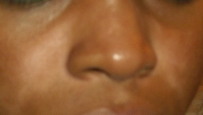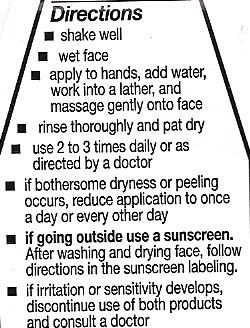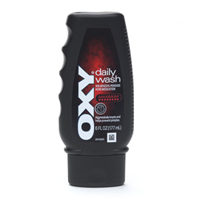November 14, 2009 – An eighteen year old Boston area college student reports that she purchased and used Oxy® Maximum Face Wash, a well known acne treatment product sold in pharmacies throughout the U.S., but eventually the skin on her face became significantly discolored in areas where she had applied the product.
The young woman first bought the over-the-counter medication in the summer of 2009 at a CVS store. She used it daily as directed for several months, but eventually noticed that she was losing skin color in the areas of her face where she had applied the face wash. She immediately ceased use of the product, but the skin discoloration remained.
Now, several months later, and even though she has not used the product again, she still has significant discolored patches on her face. Recently, she was examined by a dermatologist who was not willing to confirm whether or not the condition was permanent. In his words, “only time will tell”. Meanwhile, this young lady must now apply make-up to her face whenever she goes out, in an attempt to hide what she considers obvious disfigurement as the result of her use of the Oxy® product.
 Oxy® Face Wash, manufactured by the Mantholatum Company, Inc., is prominently advertised to contain ten percent (10%) benzoyl peroxide, a product widely used to fight acne, but which has also been reported to have side effects, causing itchy, dry skin and rashes. The product’s label and other literature give no warning that skin discoloration could occur as a result of use of the Oxy® Acne Products.
Oxy® Face Wash, manufactured by the Mantholatum Company, Inc., is prominently advertised to contain ten percent (10%) benzoyl peroxide, a product widely used to fight acne, but which has also been reported to have side effects, causing itchy, dry skin and rashes. The product’s label and other literature give no warning that skin discoloration could occur as a result of use of the Oxy® Acne Products.
Benzoyl peroxide is also commonly used as a bleaching agent in hair dyes, as an active ingredient in teeth whitening systems, and in the preparation of flour. For all these uses, it has been reported to cause bleaching or discoloration when it comes into contact with clothing or bedding.
 There are also reports that skin discoloration can result when benzoyl peroxide is used in conjunction with PABA, an ultra violet (UV) filter, used commonly in suntan lotions in the 1980’s. More recently, studies suggest that PABA may actually increase the risk of cellular UV damage and PABA has fallen out of favor with many sunscreen manufacturers.
There are also reports that skin discoloration can result when benzoyl peroxide is used in conjunction with PABA, an ultra violet (UV) filter, used commonly in suntan lotions in the 1980’s. More recently, studies suggest that PABA may actually increase the risk of cellular UV damage and PABA has fallen out of favor with many sunscreen manufacturers.
However, many water insoluble derivatives of the additive are still used in other products and PABA sunscreen is still on the market. People with sensitive skin are often advised to seek PABA-free sun tan lotion. The young woman in this case reports that she does not use sunscreens with PABA and is not aware that she used any other products on her face, which contain PABA.
 Boston Accident and Injury Lawyer
Boston Accident and Injury Lawyer


